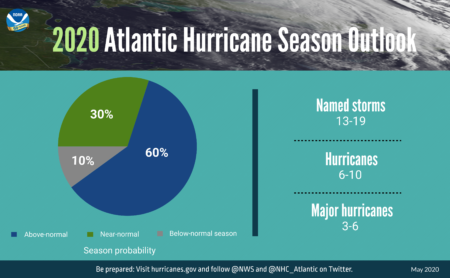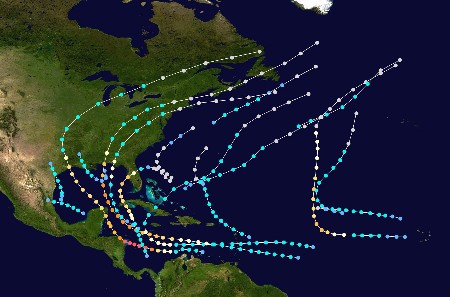May 21, 2020 – The pandemic has infected more than 5 million around the globe and caused more than 330 thousand deaths. In the U.S. alone more than 1.6 million have been infected with 95 thousand plus deaths. At the same time as the economy has faltered and life has gone into lockdown, and more than 38 million Americans have applied for economic assistance or are out of a job.
We often talk about good things coming in threes. Well it seems that bad things can also come in the same number if the latest climate predictions coming from the National Oceanic and Atmospheric Administration (NOAA) of the United States hold true.
Forecasters are stating that 2020 will be an above-normal season for Atlantic hurricanes running from June 1st through to November 30th. They have made a 70% likely prediction that between 13 and 19 named storms will rise, with between 6 and 10 of them turning into hurricanes, while 3 to 6 will becoming Category 3, 4, or 5 in intensity.
An average hurricane season produces 12 named storms, 6 hurricanes, and 3 between Category 3 and 5.
In an average hurricane year attempting to reopen the U.S. economy in a safe and healthy manner would be problematic. In an above-average year it may prove catastrophic.

Why is NOAA 70% confident in its prediction?
There are several current data trends that point to this outcome. They include:
- A lack of an El Nino (warming of the surface waters in the central Pacific) which has always acted to offset hurricane activity in the Atlantic.
- Surface temperatures in the tropical Atlantic Ocean and Caribbean Sea have been higher than normal this year.
- Evidence of reduced vertical wind shear in the Atlantic and Caribbean combined with weaker tropical Atlantic trade winds.
- Forecasts projecting an enhanced West African monsoon.
The last time a confluence of such conditions occurred led to the third-most active hurricane season ever recorded. That was back in 1995 producing 19 named storms, and 11 hurricanes of which 5 were Category 3 or higher.
An active hurricane season when added to the pandemic and economic meltdown characterized by high unemployment, an economy cycling in and out of lockdown, continued need for social distancing, plus the “normal” other disruptions of daily living, make this forecast particularly challenging.
Hurricanes are the most destructive natural weather events humanity faces annually. In the United States alone the damages an individual hurricane cause average $21.6 billion. From 1980 to 2018 the total direct damages from all hurricanes have surpassed $862 billion. These are direct hurricane damage costs and do not factor in the downstream impacts on the post-hurricane economies of the areas in the direct path of the storm tracks.
Hurricanes do their greatest destruction in achieving landfall. There is a high degree of likelihood that as many as 8 of the projected storms in 2020 will do this somewhere in the Caribbean, Central America, Mexico, or the Gulf and Atlantic States. The map appearing below was generated by a computer simulation based on the NOAA forecast. It shows projected storm tracks.

But after the hurricanes pass, in light of the existing pandemic, the additional stresses on public health systems and government services could become overwhelming. Add to that the flooding from storm surges and rain, and the loss of housing from storm damage, and it isn’t too difficult to imagine that costs could go into the trillions of dollars.
There is one more fact that needs to be understood. In the face of global warming, hurricanes are getting more destructive over the past two decades. By how much? For 2017 alone, Hurricane Harvey, Irma, and Maria were three of the five costliest hurricanes in American history. Total economic losses from all hurricanes that year amounted to five times the average of hurricanes in the preceding 16 years.
In 1995, the last year to follow the current forecasted pattern, damage from rainfall, storm surges, wind, and flooding in the three largest storms of that season amounted to $8.1 billion, $3.6 billion, and $1.5 billion respectively. Multiply those numbers by a factor of 5 and then include a dysfunctional economy, mass unemployment, and the ongoing pandemic and you begin to realize the enormity of the threat represented by NOAA’s prediction for this coming Atlantic hurricane season.








